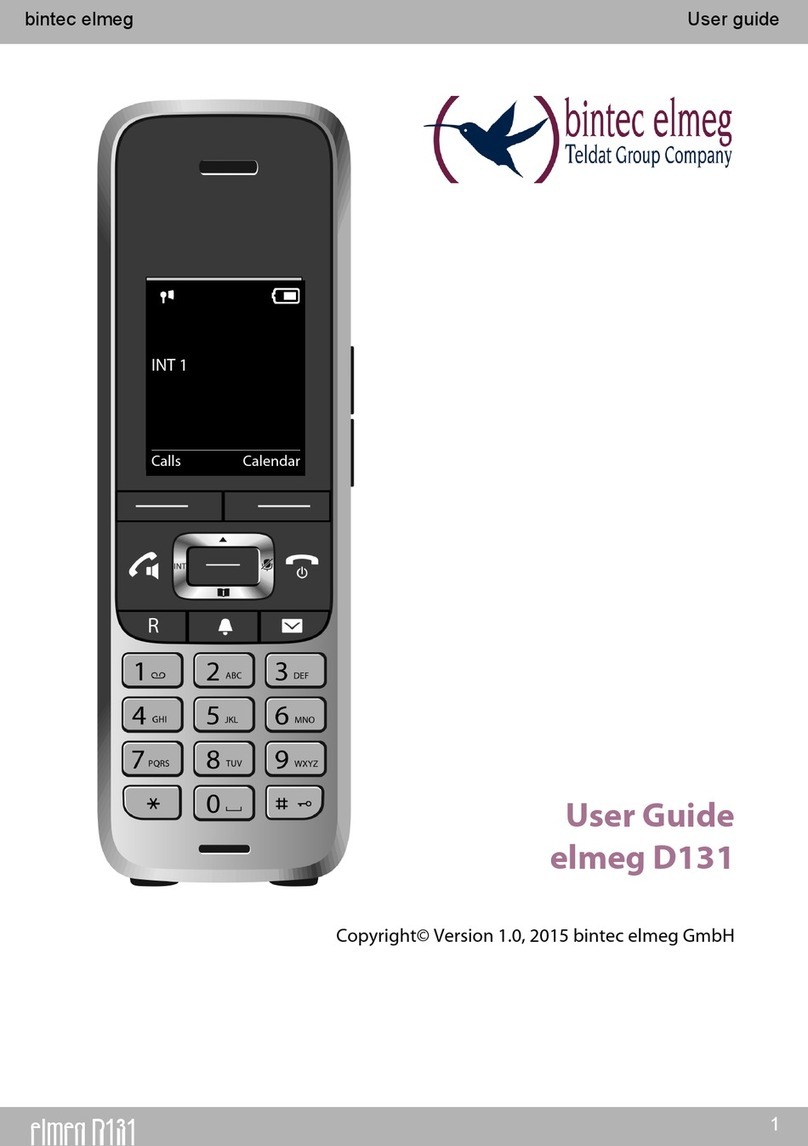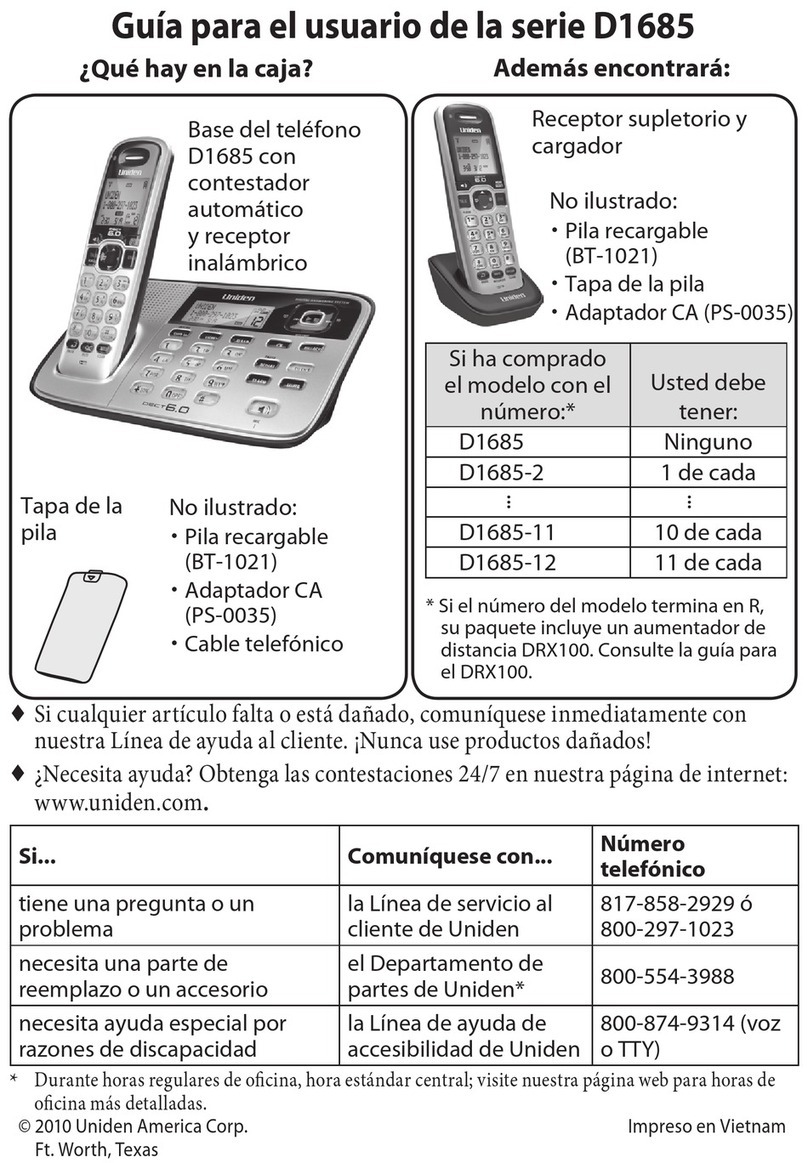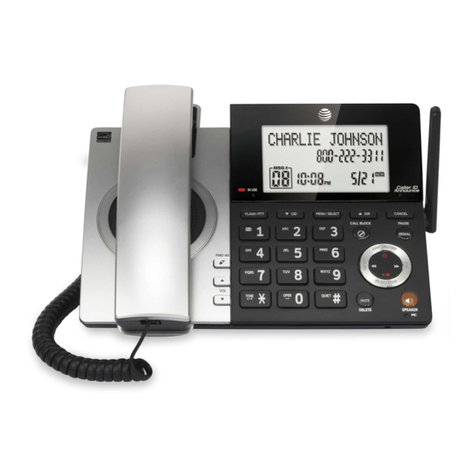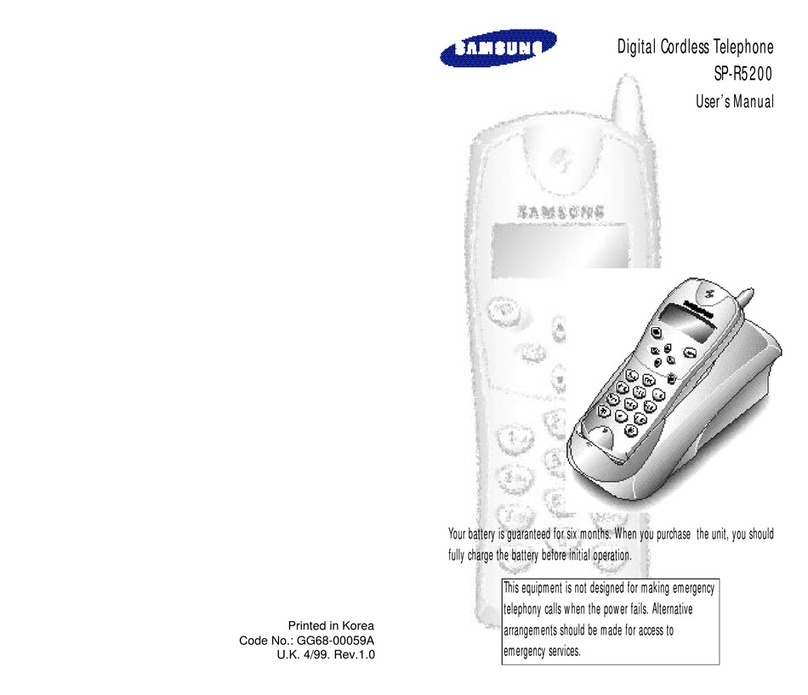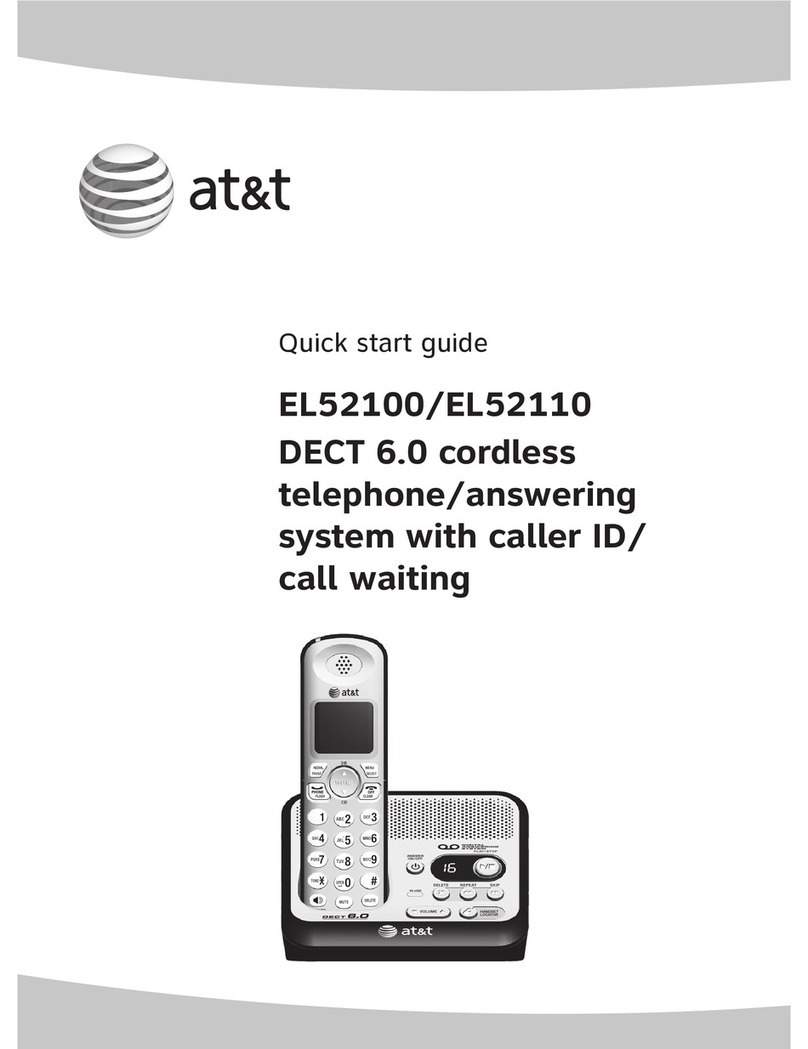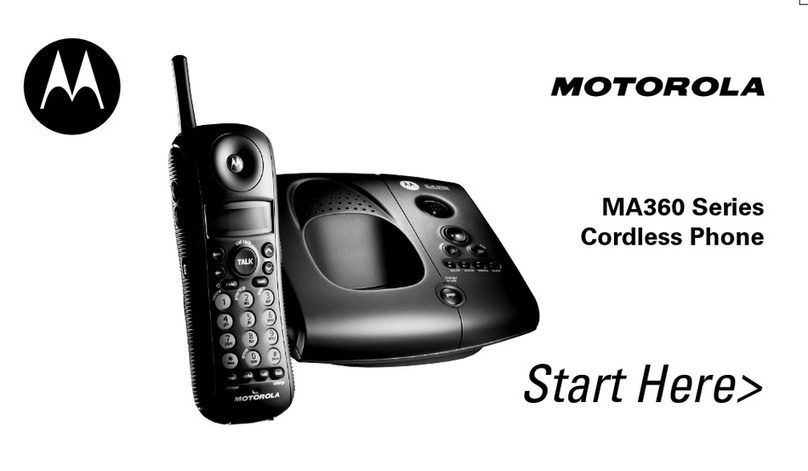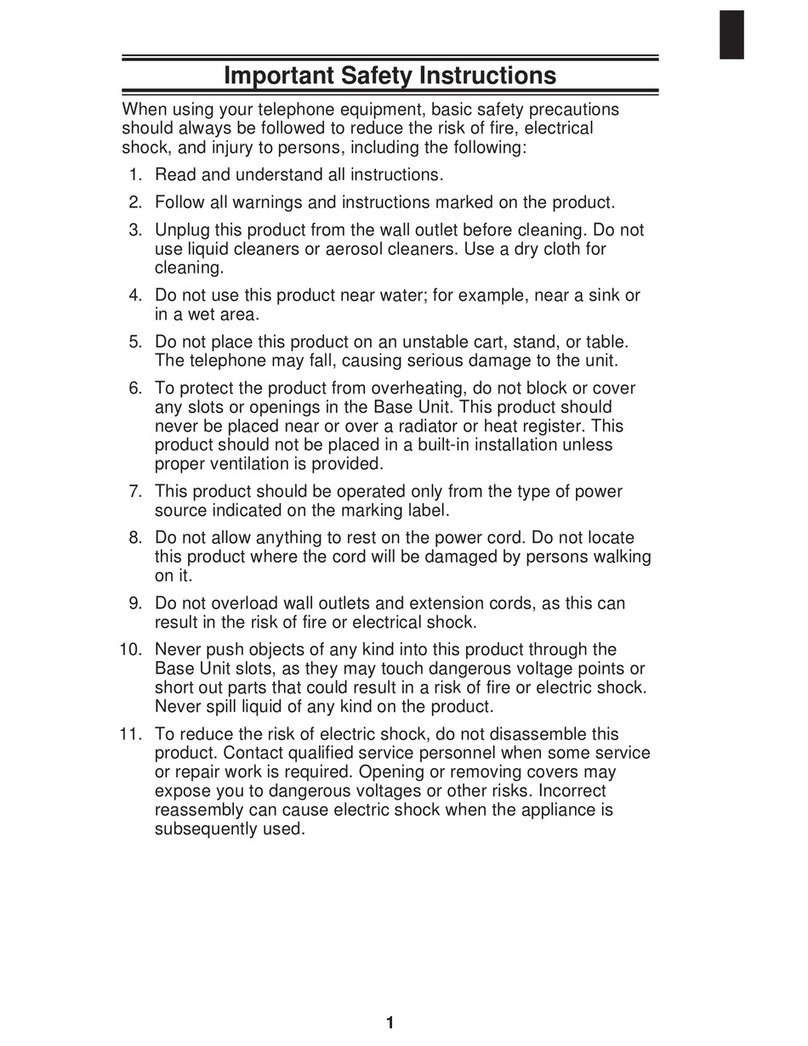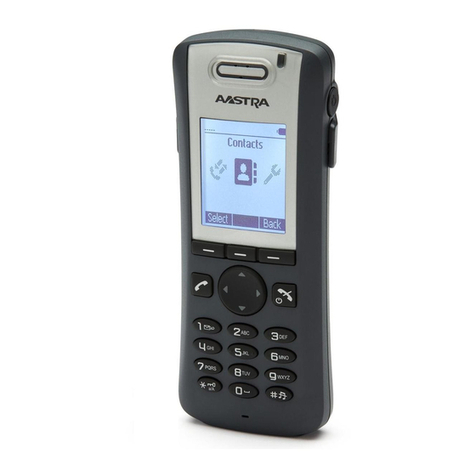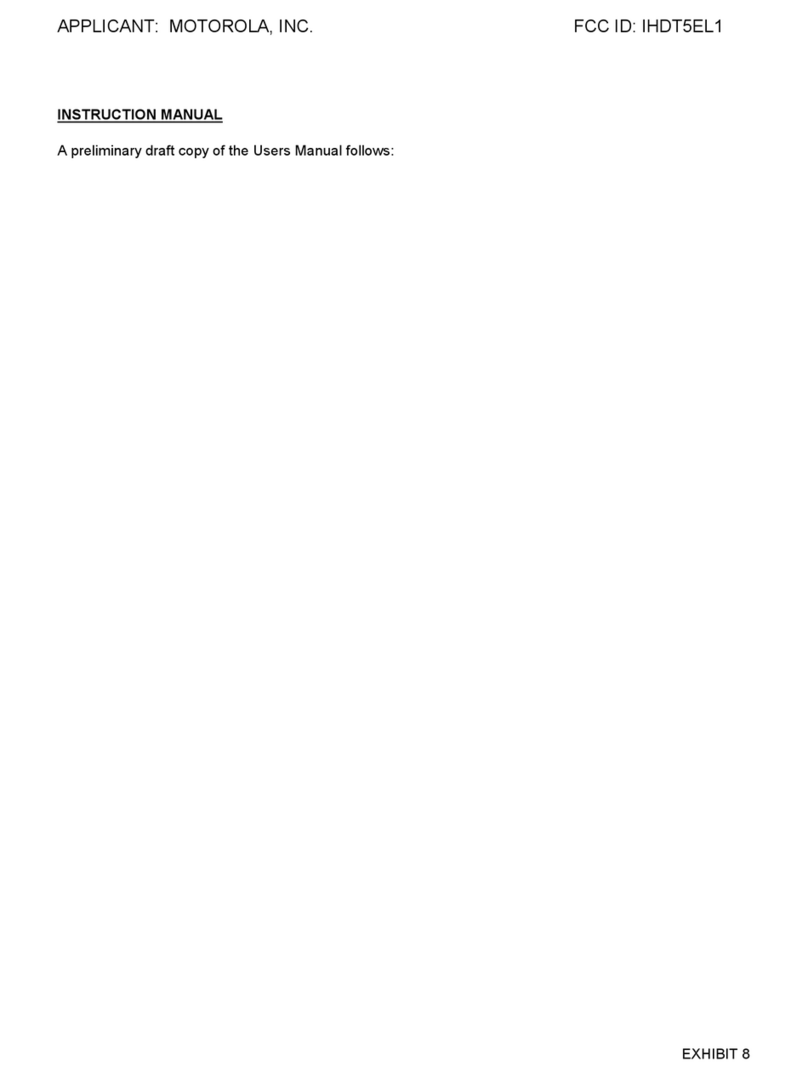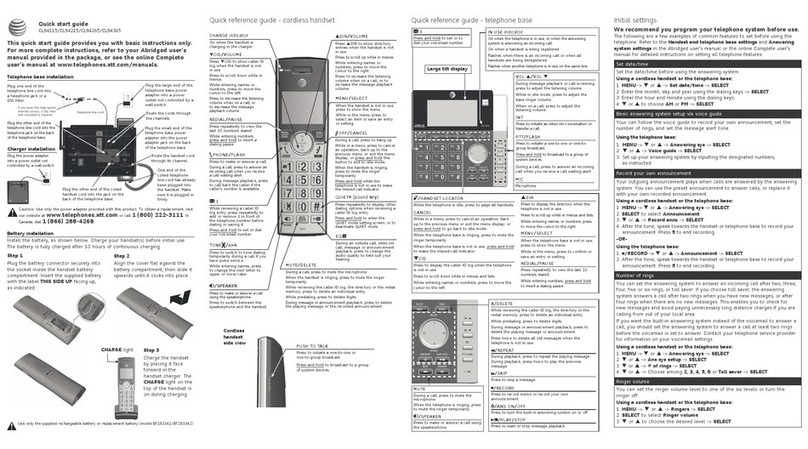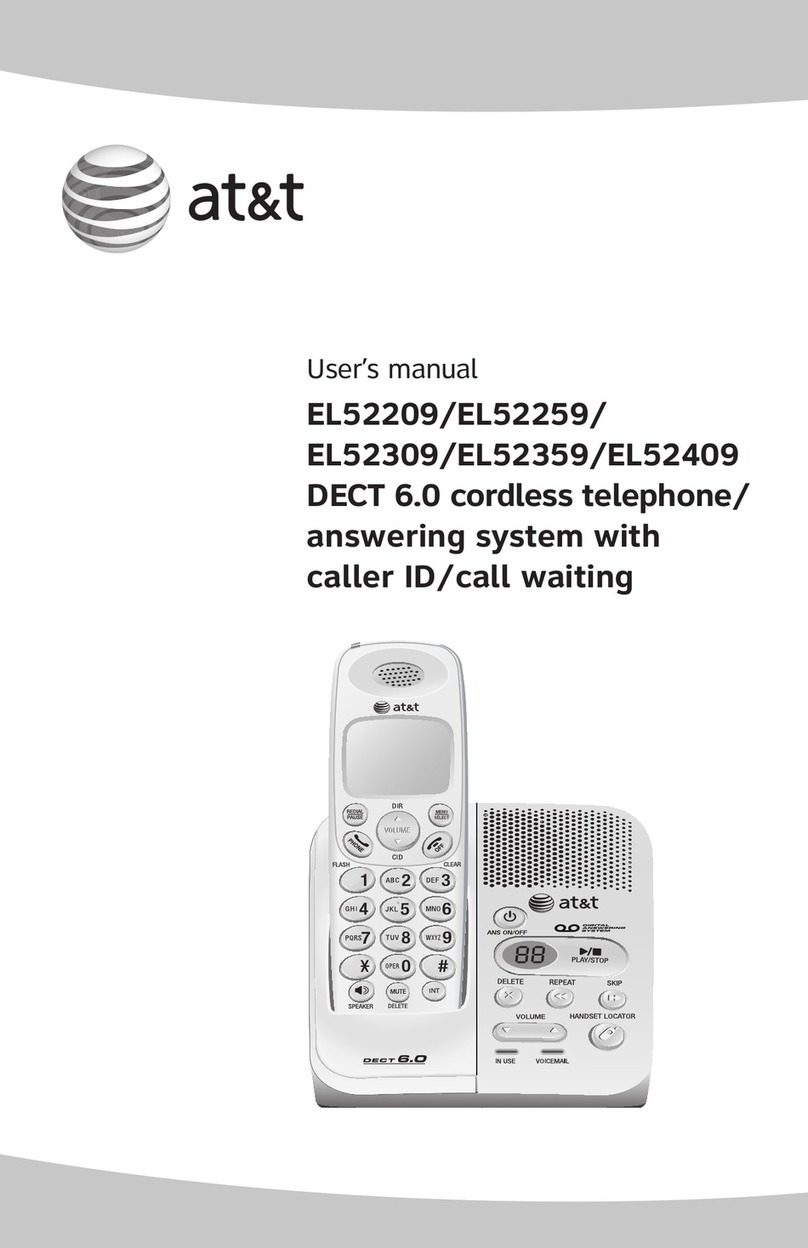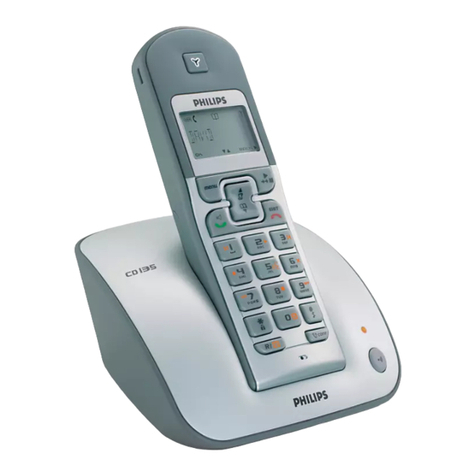BinTec elmeg D130 User manual

elmeg D130 / en / elmegD130_en / Cover_front.fm / 02.10.2013
Version 1, 01.07.2012
1
elmeg D130
bintec elmeg User Guide
Copyright© Version 1.0, 2013 bintec elmeg GmbH
User Guide
elmeg D130

elmeg D130 / en / elmegD130_en / Cover_front.fm / 02.10.2013
Version 1, 01.07.2012
2elmeg D130
bintec elmegUser Guide
Legal Notice
Aim and purpose
This document is part of the user manual for the installation and configuration of bintec elgmeg
devices. For the latest information and notes on the current software release, please also read our
release notes, particularly if you are updating your software to a higher release version. You will find
the latest release notes under www.bintec-elmeg.com.
Liability
This manual has been put together with the greatest possible care. However, the information con-
tained in this manual is not a guarantee of the properties of your product. bintec elmeg GmbH is
only liable within the terms of its conditions of sale and supply and accepts no liability for technical
inaccuracies and/or omissions.
The information in this manual can be changed without notice. You will find additional information
and also release notes for Teldat devices under www.teldat.com .
bintec elmeg devices make WAN connections as a possible function of the system configuration.
You must monitor the product in order to avoid unwanted charges. bintec elmeg GmbH accepts
no responsibility for data loss, unwanted connection costs and damage caused by unintended
operation of the product.
Trademarks
bintec trademarks and the bintec logo, artem trademarks and the artem logo, elmeg trademarks
and the elmeg logo are registered trademarks of bintec elmeg GmbH.
Company and product names mentioned are usually trademarks of the companies or manufactu-
rers concerned.
Copyright
All rights reserved. No part of this manual may be reproduced or further processed in any way wit-
hout the written consent of bintec elmeg GmbH. The documentation may not be processed and,
in particular, translated without the consent of bintec elmeg GmbH.
You will find information on guidelines and standards in the declarations of conformity under
www.bintec-elmeg.com.
How to reach bintec elmeg GmbH
bintec elmeg GmbH
a Teldat Group Company
Südwestpark 94, D-90449 Nürnberg, Deutschland,
Telefon: +4991196730, Fax: +499116880725
Internet: www.bintec-elmeg.com
© bintec elmeg GmbH 2013, All rights reserved. Rights of modification reserved.

elmeg D130 / engbt / elmegD130_en / introduction.fm / 02.10.2013
Version 1, 01.07.2012
3elmeg D130
bintec elmeg elmeg D130– more than just a telephone
elmeg D130– more than just a telephone
Your telephone sets new standards for the way you communicate at home.
The configuration and user interface of the cordless phone are excellent, providing you with
first-class voice quality in handsfree mode, while the various ports (Bluetooth, USB) offer you
enormous flexibility.
The large TFT display, user-friendly keypad and clearly laid out menu are very simple to use.
Your phone can do a whole lot more:
uYou can use Bluetooth™ for wireless communication with other devices (e.g. headsets) that
also use this technology.
uYou can synchronise your Directories on your telephone, mobile phone and PC via Blue-
toothTM or the USB port using the Gigaset QuickSync software (¢page 58).
uYou can save appointments (¢page 39) and anniversaries, e.g., birthdays (¢page 34), in
your phone and it will remind you of them in advance.
uYou can designate important people as VIPs to identify important calls from the ringtone
(¢page 31).
uYou can assign a picture to entries in the Directory – in future the picture will appear every
time you receive a call from this number (¢page 31).
uIf you do not want to take calls where the caller has withheld their number, just set your
handset to only ring if Calling Line Identification has not been withheld (¢page 50).
uIf you do not wish to be disturbed, you can simply set up a time control so that your phone
will only ring when it is convenient (¢page 49). VIP calls are still connected.
uYou can assign important numbers to the number keys on your phone. The number is then
dialled by simply pressing a key (¢page 46).
uAdapt your phone to suit your handsfree requirements (¢page 49) and adjust the bright-
ness of your keypad to suit you (¢page 48).
uView your personal pictures as a screensaver slide show (¢page 47).
uYou can set the display to large font to increase readability in particularly important situa-
tions (e.g., the Directory and lists) (¢page 47).
uYou can adapt the menu display to suit your individual requirements so that only the most
important functions (standard mode) or all functions (expert mode) are displayed
(¢page 26).
You can find additional information about your phone at
www.bintec-elmeg.com.
Have fun using your new phone!

elmeg D130 / engbt / elmegD130_en / overview.fm / 02.10.2013
Version 1, 01.07.2012
4elmeg D130
bintec elmegThe handset at a glance
The handset at a glance
Illustration of handset on a base with SMS
functionality.
1Display in idle status
2Battery charge status (¢page 17)
3Sidekeys
Set call (¢page 48) or
ringtone volume (¢page 49)
4Display keys (¢page 21)
5Message key (¢page 36)
Access to Call and Message Lists;
Flashes: new message or new call
6End call key, On/Off key
End call, cancel function, go back one menu
level (press briefly), back to idle status
(press and hold), activate/deactivate handset
(press and hold in idle status)
7Hash key
Keypad Lock on/off (press and hold in
idle status);
Toggles between upper/lower case and digits
8Mute key (¢page 29)
Mute the microphone
9Microphone
10 Recall key
- Consultation call (flash)
- Insert a dialling pause (press and hold)
11 Star key
Ringtone on/off (press and hold);
with an open connection: switch between
pulse dialling/tone dialling (press briefly);
text input: open table of special characters
12 Headset socket (¢page 17)
13 Key 1
Dial Network Mailbox (press and hold)
14 Talk key
Flashes: incoming call;
Accept a call; open Redial List (press briefly);
start dialling (press and hold);
When writing an SMS: send SMS
15 Handsfree key
Switch between earpiece and handsfree mode
16 Control key (¢page 20)
17 Signal strength (¢page 17)
Green: Eco Mode (¢page 39) activated
i
V
07:15
INT 1 14 Oct
Calls SMS
2
4
6
5
7
8
16
14
9
1
15
17
11
13
3
10
12
Please note
The product images are depicted schematically and may differ from the actual appearance
of the product.

elmeg D130 / en / elmegD130_en / overview.fm / 02.10.2013
Version 1, 01.07.2012
5elmeg D130
bintec elmeg The handset at a glance
Display symbols
The following symbols are displayed dependent on the settings and the operating status of
your telephone:
Ø«Ú
Signalling
External call (¢page 29)
Ø
å
Ú
Internal call (¢page 30)
i
Û08:00 07:15
INT 1 14 Oct
Ù ¾
02 10 09 08
Calls SMS
ØðÚ
Anniversary (¢page 40)
ØìÚ
Alarm (¢page 41)
Signal strength i(¢page 39)
or ECO Mode+ icon ¼(¢page 39)
Ringtone switched off (¢page 50)
or ñalert tone activated (¢page 50)
Keypad Lock switched on (¢page 23)
ØáÚ
Appointment (¢page 40)
Batteries are charged (¢page 17)
Charge status of the batteries (¢page 17)
Alarm switched on and wake-up time set (¢page 41)
Current time (¢page 15)
Current day and month (¢page 15)
Name of the handset
Number of new messages:
u
Ã
on the Network Mailbox (¢page 36)
u™in the Missed Calls List (¢page 36)
u¾in the SMS List (dependent on base,¢page 35)
uin the Missed Alarms List (¢page 37)
V

elmeg D130 / engbt / elmegD130_en / elmeg_130IVZ.fm / 02.10.2013
Version 1, 01.07.2012
6elmeg D130
bintec elmegContents
Contents
elmeg D130– more than just a telephone . . . . . . . . . . . . . . . . . . . . . . . . . . . . . . . . . . . . . 3
The handset at a glance . . . . . . . . . . . . . . . . . . . . . . . . . . . . . . . . . . . . . . . . . . . . . . . . . . . . . . 4
Display symbols . . . . . . . . . . . . . . . . . . . . . . . . . . . . . . . . . . . . . . . . . . . . . . . . . . . . . . . . . . . . . 5
Safety precautions . . . . . . . . . . . . . . . . . . . . . . . . . . . . . . . . . . . . . . . . . . . . . . . . . . . . . . . . . . . 8
First steps . . . . . . . . . . . . . . . . . . . . . . . . . . . . . . . . . . . . . . . . . . . . . . . . . . . . . . . . . . . . . . . . . . . 9
Checking the package contents . . . . . . . . . . . . . . . . . . . . . . . . . . . . . . . . . . . . . . . . . . . . . . . . . . . . . . . . . . . 9
Setting up the charger . . . . . . . . . . . . . . . . . . . . . . . . . . . . . . . . . . . . . . . . . . . . . . . . . . . . . . . . . . . . . . . . . . . 10
Connecting the charger . . . . . . . . . . . . . . . . . . . . . . . . . . . . . . . . . . . . . . . . . . . . . . . . . . . . . . . . . . . . . . . . . . 10
Setting up the handset for use . . . . . . . . . . . . . . . . . . . . . . . . . . . . . . . . . . . . . . . . . . . . . . . . . . . . . . . . . . . 11
Changing the display language . . . . . . . . . . . . . . . . . . . . . . . . . . . . . . . . . . . . . . . . . . . . . . . . . . . . . . . . . . 13
Registering the handset . . . . . . . . . . . . . . . . . . . . . . . . . . . . . . . . . . . . . . . . . . . . . . . . . . . . . . . . . . . . . . . . . . 14
Setting the date and time . . . . . . . . . . . . . . . . . . . . . . . . . . . . . . . . . . . . . . . . . . . . . . . . . . . . . . . . . . . . . . . . 15
Connecting the headset . . . . . . . . . . . . . . . . . . . . . . . . . . . . . . . . . . . . . . . . . . . . . . . . . . . . . . . . . . . . . . . . . . 17
Connecting the USB data cable . . . . . . . . . . . . . . . . . . . . . . . . . . . . . . . . . . . . . . . . . . . . . . . . . . . . . . . . . . . 18
What would you like to do next? . . . . . . . . . . . . . . . . . . . . . . . . . . . . . . . . . . . . . . . . . . . . . . . . . . . . . . . . . . 19
Using the phone . . . . . . . . . . . . . . . . . . . . . . . . . . . . . . . . . . . . . . . . . . . . . . . . . . . . . . . . . . . . 20
Using the control key . . . . . . . . . . . . . . . . . . . . . . . . . . . . . . . . . . . . . . . . . . . . . . . . . . . . . . . . . . . . . . . . . . . . 20
Using the display keys . . . . . . . . . . . . . . . . . . . . . . . . . . . . . . . . . . . . . . . . . . . . . . . . . . . . . . . . . . . . . . . . . . . . 21
Using the keys on the keypad . . . . . . . . . . . . . . . . . . . . . . . . . . . . . . . . . . . . . . . . . . . . . . . . . . . . . . . . . . . . 21
Using the side keys . . . . . . . . . . . . . . . . . . . . . . . . . . . . . . . . . . . . . . . . . . . . . . . . . . . . . . . . . . . . . . . . . . . . . . 21
Correcting incorrect entries . . . . . . . . . . . . . . . . . . . . . . . . . . . . . . . . . . . . . . . . . . . . . . . . . . . . . . . . . . . . . . 21
Using the menus . . . . . . . . . . . . . . . . . . . . . . . . . . . . . . . . . . . . . . . . . . . . . . . . . . . . . . . . . . . . . . . . . . . . . . . . . 22
Activating/deactivating the handset . . . . . . . . . . . . . . . . . . . . . . . . . . . . . . . . . . . . . . . . . . . . . . . . . . . . . . 23
Activating/deactivating Keypad Lock . . . . . . . . . . . . . . . . . . . . . . . . . . . . . . . . . . . . . . . . . . . . . . . . . . . . . 23
Using this guide . . . . . . . . . . . . . . . . . . . . . . . . . . . . . . . . . . . . . . . . . . . . . . . . . . . . . . . . . . . . . . . . . . . . . . . . . 24
Menu overview . . . . . . . . . . . . . . . . . . . . . . . . . . . . . . . . . . . . . . . . . . . . . . . . . . . . . . . . . . . . . 26
Making calls . . . . . . . . . . . . . . . . . . . . . . . . . . . . . . . . . . . . . . . . . . . . . . . . . . . . . . . . . . . . . . . . 28
Making an external call . . . . . . . . . . . . . . . . . . . . . . . . . . . . . . . . . . . . . . . . . . . . . . . . . . . . . . . . . . . . . . . . . . . 28
One Touch Call . . . . . . . . . . . . . . . . . . . . . . . . . . . . . . . . . . . . . . . . . . . . . . . . . . . . . . . . . . . . . . . . . . . . . . . . . . . 28
Ending a call . . . . . . . . . . . . . . . . . . . . . . . . . . . . . . . . . . . . . . . . . . . . . . . . . . . . . . . . . . . . . . . . . . . . . . . . . . . . . 28
Accepting a call . . . . . . . . . . . . . . . . . . . . . . . . . . . . . . . . . . . . . . . . . . . . . . . . . . . . . . . . . . . . . . . . . . . . . . . . . . 29
Using handsfree mode . . . . . . . . . . . . . . . . . . . . . . . . . . . . . . . . . . . . . . . . . . . . . . . . . . . . . . . . . . . . . . . . . . . 29
Switching to mute . . . . . . . . . . . . . . . . . . . . . . . . . . . . . . . . . . . . . . . . . . . . . . . . . . . . . . . . . . . . . . . . . . . . . . . 29
Making internal calls . . . . . . . . . . . . . . . . . . . . . . . . . . . . . . . . . . . . . . . . . . . . . . . . . . . . . . . . . . . . . . . . . . . . . 30
Using the Directory and lists . . . . . . . . . . . . . . . . . . . . . . . . . . . . . . . . . . . . . . . . . . . . . . . . . 31
Using the Directory . . . . . . . . . . . . . . . . . . . . . . . . . . . . . . . . . . . . . . . . . . . . . . . . . . . . . . . . . . . . . . . . . . . . . . 31
Using the Redial List . . . . . . . . . . . . . . . . . . . . . . . . . . . . . . . . . . . . . . . . . . . . . . . . . . . . . . . . . . . . . . . . . . . . . 35
Using the Incoming SMS Message List (dependent on base) . . . . . . . . . . . . . . . . . . . . . . . . . . . . . . . 35
Using the Call Lists . . . . . . . . . . . . . . . . . . . . . . . . . . . . . . . . . . . . . . . . . . . . . . . . . . . . . . . . . . . . . . . . . . . . . . . 35
Message key function . . . . . . . . . . . . . . . . . . . . . . . . . . . . . . . . . . . . . . . . . . . . . . . . . . . . . . . . . . . . . . . . . . . . 36
Using the Missed Alarms List . . . . . . . . . . . . . . . . . . . . . . . . . . . . . . . . . . . . . . . . . . . . . . . . . . . . . . . . . . . . . 37

elmeg D130 / engbt / elmegD130_en / elmeg_130IVZ.fm / 02.10.2013
Version 1, 01.07.2012
7elmeg D130
bintec elmeg Contents
Using the Network Mailbox . . . . . . . . . . . . . . . . . . . . . . . . . . . . . . . . . . . . . . . . . . . . . . . . . 38
Configuring fast access for the Network Mailbox . . . . . . . . . . . . . . . . . . . . . . . . . . . . . . . . . . . . . . . . . . 38
Viewing the Network Mailbox message . . . . . . . . . . . . . . . . . . . . . . . . . . . . . . . . . . . . . . . . . . . . . . . . . . . 38
ECO DECT . . . . . . . . . . . . . . . . . . . . . . . . . . . . . . . . . . . . . . . . . . . . . . . . . . . . . . . . . . . . . . . . . . 39
Setting an appointment (Calendar) . . . . . . . . . . . . . . . . . . . . . . . . . . . . . . . . . . . . . . . . . . 39
Displaying missed appointments, anniversaries . . . . . . . . . . . . . . . . . . . . . . . . . . . . . . . . . . . . . . . . . . . 41
Setting the Alarm Clock . . . . . . . . . . . . . . . . . . . . . . . . . . . . . . . . . . . . . . . . . . . . . . . . . . . . . 41
Using a handset as a Room Monitor (Babyphone) . . . . . . . . . . . . . . . . . . . . . . . . . . . . . 42
Using Bluetooth devices . . . . . . . . . . . . . . . . . . . . . . . . . . . . . . . . . . . . . . . . . . . . . . . . . . . . 44
Setting up the handset . . . . . . . . . . . . . . . . . . . . . . . . . . . . . . . . . . . . . . . . . . . . . . . . . . . . . . 46
Setting the Handset PIN . . . . . . . . . . . . . . . . . . . . . . . . . . . . . . . . . . . . . . . . . . . . . . . . . . . . . . . . . . . . . . . . . . 46
Quickly accessing numbers and functions . . . . . . . . . . . . . . . . . . . . . . . . . . . . . . . . . . . . . . . . . . . . . . . . 46
Changing the display language . . . . . . . . . . . . . . . . . . . . . . . . . . . . . . . . . . . . . . . . . . . . . . . . . . . . . . . . . . 47
Setting the display . . . . . . . . . . . . . . . . . . . . . . . . . . . . . . . . . . . . . . . . . . . . . . . . . . . . . . . . . . . . . . . . . . . . . . . 47
Setting keypad illumination . . . . . . . . . . . . . . . . . . . . . . . . . . . . . . . . . . . . . . . . . . . . . . . . . . . . . . . . . . . . . . 48
Activating/deactivating Auto Answer . . . . . . . . . . . . . . . . . . . . . . . . . . . . . . . . . . . . . . . . . . . . . . . . . . . . . 48
Changing the speaker/earpiece volume . . . . . . . . . . . . . . . . . . . . . . . . . . . . . . . . . . . . . . . . . . . . . . . . . . 48
Setting a handsfree profile . . . . . . . . . . . . . . . . . . . . . . . . . . . . . . . . . . . . . . . . . . . . . . . . . . . . . . . . . . . . . . . 49
Changing ringtones . . . . . . . . . . . . . . . . . . . . . . . . . . . . . . . . . . . . . . . . . . . . . . . . . . . . . . . . . . . . . . . . . . . . . . 49
Using the Resource Directory . . . . . . . . . . . . . . . . . . . . . . . . . . . . . . . . . . . . . . . . . . . . . . . . . . . . . . . . . . . . . 50
Activating/deactivating Advisory Tones . . . . . . . . . . . . . . . . . . . . . . . . . . . . . . . . . . . . . . . . . . . . . . . . . . . 51
Setting your own area code . . . . . . . . . . . . . . . . . . . . . . . . . . . . . . . . . . . . . . . . . . . . . . . . . . . . . . . . . . . . . . 52
Restoring the handset default settings . . . . . . . . . . . . . . . . . . . . . . . . . . . . . . . . . . . . . . . . . . . . . . . . . . . . 52
Service (Customer Care) . . . . . . . . . . . . . . . . . . . . . . . . . . . . . . . . . . . . . . . . . . . . . . . . . . . . . 53
Questions and answers . . . . . . . . . . . . . . . . . . . . . . . . . . . . . . . . . . . . . . . . . . . . . . . . . . . . . . . . . . . . . . . . . . 53
Authorisation . . . . . . . . . . . . . . . . . . . . . . . . . . . . . . . . . . . . . . . . . . . . . . . . . . . . . . . . . . . . . . . . . . . . . . . . . . . . 54
Quality Management according to DIN EN ISO 9001 . . . . . . . . . . . . . . . . . . . . . . . . . . . . . . . . . . . . . . . 54
Appendix . . . . . . . . . . . . . . . . . . . . . . . . . . . . . . . . . . . . . . . . . . . . . . . . . . . . . . . . . . . . . . . . . . 55
Caring for your telephone . . . . . . . . . . . . . . . . . . . . . . . . . . . . . . . . . . . . . . . . . . . . . . . . . . . . . . . . . . . . . . . . 55
Contact with liquid . . . . . . . . . . . . . . . . . . . . . . . . . . . . . . . . . . . . . . . . . . . . . . . . . . . . . . . . . . . . . . . . . . . . . . 55
Specifications . . . . . . . . . . . . . . . . . . . . . . . . . . . . . . . . . . . . . . . . . . . . . . . . . . . . . . . . . . . . . . . . . . . . . . . . . . . . 55
Writing and editing text . . . . . . . . . . . . . . . . . . . . . . . . . . . . . . . . . . . . . . . . . . . . . . . . . . . . . . . . . . . . . . . . . . 56
Accessing additional functions via the PC interface . . . . . . . . . . . . . . . . . . . . . . . . . . . 58
Mounting the charger on the wall 60
Index . . . . . . . . . . . . . . . . . . . . . . . . . . . . . . . . . . . . . . . . . . . . . . . . . . . . . . . . . . . . . . . . . . . . . . 61

elmeg D130 / engbt / elmegD130_en / security.fm / 02.10.2013
Version 1, 01.07.2012
8elmeg D130
bintec elmegSafety precautions
Safety precautions
Warning
Read the safety precautions and the user guide before use.
Comprehensive user guides for all telephones and telephone systems as well as for acces-
sories can be found online at www.bintec-elmeg.com. We thereby help to save paper
while providing fast access to the complete up-to-date documentation at any time.
Use only the power adapter indicated on the device.
Use only rechargeable batteries that correspond to the specification. Never use a conven-
tional (non-rechargeable) battery or other battery types as this could result in significant health
risks and personal injury. Rechargeable batteries, which are noticeably damaged, must be
replaced.
Using your telephone may affect nearby medical equipment. Be aware of the technical condi-
tions in your
particular environment, e.g. doctor's surgery.
If you use a medical device (e.g. a pacemaker), please contact the device manufacturer. They
will be able to advise you regarding the susceptibility of the device to external sources of high
frequency energy (for the specifications of your bintec elmeg product see "Technical Data").
Do not hold the rear of the handset to your ear when it is ringing or when speaker mode is acti-
vated. Otherwise you risk serious and permanent damage to your hearing.
Your phone is compatible with the majority of digital hearing aids on the market. However, per-
fect function with all hearing aids cannot be guaranteed.
The phone may cause interference in analogue hearing aids (humming or whistling) or cause
them to overload. If you require assistance, please contact the hearing aid supplier.
The base and charger are not splashproof. For this reason do not install them in a damp envi-
ronment such as bathrooms or shower rooms.
Do not use the devices in environments with a potential explosion hazard (e.g. paint shops).
If you give your phone to a third party, make sure you also give them the user guide.
Remove faulty devices from use or have them repaired by our Service team, as these could
interfere with other wireless services.
Please note
uThe device cannot be used in the event of a power failure. It is also not possible to trans-
mit emergency calls.
uEmergency numbers cannot be dialled if the keypad lock is activated!

elmeg D130 / engbt / elmegD130_en / starting.fm / 02.10.2013
Version 1, 01.07.2012
9elmeg D130
bintec elmeg First steps
First steps
Checking the package contents
1One elmeg D130 handset
2Two batteries
3One battery cover
4One charger
5One power adapter
6One belt clip
7One plastic headset socket cover
213
45
76

elmeg D130 / engbt / elmegD130_en / starting.fm / 02.10.2013
Version 1, 01.07.2012
10 elmeg D130
bintec elmegFirst steps
Setting up the charger
The charger is designed for use in dry rooms in a temperature range of +5°C to +45°C.
¤Place the charger on a level, non-slip surface or mount it on the wall (¢page 60).
The phone's feet do not usually leave any marks on surfaces. However, due to the multitude of
different varnishes and polishes used on today's furnishings, the occurrence of marks on the
surfaces cannot be completely ruled out.
Please note:
uNever expose the telephone to the influence of heat sources, direct sunlight or other electri-
cal devices.
uProtect your phone from moisture, dust, corrosive liquids and fumes.
Connecting the charger
Please note
Pay attention to the range of the base.
This is up to 300 m in unobstructed outdoor areas and up to 50 m inside buildings. The range
is reduced when Eco Mode (¢page 39) is activated.
¤Plug the power adapter into the plug
socket 2.
¤Connect the flat plug from the power
adapter 1.
To disconnect the plug from the charger, press the
release button 3and disconnect the plug 4.
1
2
3
4
1
2

elmeg D130 / engbt / elmegD130_en / starting.fm / 02.10.2013
Version 1, 01.07.2012
11elmeg D130
bintec elmeg First steps
Setting up the handset for use
The display and keypad are protected by plastic films.
Remove the protective films!
Inserting the batteries and closing the battery cover
Warning
Use only rechargeable batteries recommended by bintec-elmec GmbH (¢page 55), i.e.,
never use a conventional (non-rechargeable) battery, as this could result in significant health
risks and personal injury. For example, the outer casing of the batteries could be damaged
or the batteries could explode. The phone could also malfunction or be damaged as a result
of using batteries that are not of the recommended type.
¤Insert the batteries with the polarity in the
correct direction.
The polarity is indicated in/on the battery
compartment.
¤First insert the battery cover at the top.
¤Then press the cover until it clicks into
place.
To open the battery cover, for instance to
replace the batteries, insert a coin into the
cavity on the left-hand side of the casing,
then pull the battery cover in an upward
direction.

elmeg D130 / engbt / elmegD130_en / starting.fm / 02.10.2013
Version 1, 01.07.2012
12 elmeg D130
bintec elmegFirst steps
¤Insert the plastic cover provided for the headset socket to
ensure optimum sound in handsfree mode.
Attaching the belt clip
The handset has notches on each side to attach the belt clip.
¤To attach – press the belt clip onto the back of
the handset so that the protrusions on the
belt clip engage with the notches.
¤To remove – press the centre of the belt clip
firmly with your right thumb, push the finger-
nail of your left index finger up between the
clip and the housing and pull the clip in an
upward direction.
Initial charging and discharging of the batteries
The correct charge level can only be displayed if the batteries are first fully charged and dis-
charged.
¤Charge the handset in the charging cradle for 8.5
hours.
¤After charging, remove the handset from the
charging cradle and only replace it when the bat-
teries are fully discharged.
Please note
The handset must only be placed in the desig-
nated base or charging cradle.
Please note
uAfter the initial battery charge and discharge, you may place your handset in the base
after every call.
uAlways repeat the charging and discharging procedure if you remove the batteries from
the handset and reinsert them.
uThe batteries may warm up during charging. This is not dangerous.
uAfter a while, the charge capacity of the batteries will decrease for technical reasons.
8.5 h

elmeg D130 / engbt / elmegD130_en / starting.fm / 02.10.2013
Version 1, 01.07.2012
13elmeg D130
bintec elmeg First steps
Changing the display language
Change the display language if you do not understand the language currently set.
¤Press and hold the end call key ato return to idle status.
O
5
¤Press right on the control key.
¤Slowly press keys Oand 5one after the other.
The display for setting languages appears. The current
language (e.g. English) is selected.
¤Press down on the control key s...
... until the language you wish to use is marked, e.g.,
French.
¤Press the right key directly below the display to
select this language.
The selection is marked with Ø.
Deutsch ±
English Ø
Francais ±
It li ±
Deutsch ±
English Ø
Francais ±
Italiano ±
Espanol ±
x
Back Select
Deutsch ±
English ±
Francais Ø
It li ±

elmeg D130 / engbt / elmegD130_en / starting.fm / 02.10.2013
Version 1, 01.07.2012
14 elmeg D130
bintec elmegFirst steps
Registering the handset
A elmeg D130 handset can be registered on up to four bases. You must initiate handset regis-
tration on the handset and on the base.
When the registration process has completed successfully, the handset returns to idle status.
The handset's internal number is shown in the display, e.g., INT 1. If not, repeat the procedure.
On the handset
On the base
Within 60 sec. press and hold the registration/paging key on the base (approx. 3 sec.).
Please note
If the handset is already registered to at least one base, start the registration process as fol-
lows:
v¢Ï¢Registration ¢Register Handset
If the handset is already registered to four bases, select the required base.
Please note
For instructions on deregistering the handsets, please consult the base user guide.
Register
¤Press the key below §Register§ on the display
screen.
A message appears stating that the handset is
searching for a base that is ready for registration.

elmeg D130 / engbt / elmegD130_en / starting.fm / 02.10.2013
Version 1, 01.07.2012
15elmeg D130
bintec elmeg First steps
Setting the date and time
Set the date and time so that the correct date and time can be assigned to incoming calls, and
so that the alarm can be used.
¤Press the key below §Time§ on the display screen to
open the input field.
(If you have already set the time and date, open the
input field via the menu, ¢page 27.)
The Date/Time submenu is shown on the display.
¤The active input position flashes.
Enter day, month and year as an 8-digit number via
the keypad,
e.g., 4Q2Q for 14/
10/2011.
Date/Time
Date:
31.01.2011
Time:
00:00
Back Save
Calls Time
Press the right or left control key to change the
input position and correct an entry.
¤Enter the hours and minutes as four digit numbers
via the keypad,
e.g., QM5for 07:15 am.
Change the input position with the control key if
necessary.
¤Press down on the control key to switch
to the Time input field.
Date/Time
Date:
14.10.2011
Time:
00:00
Back Save

elmeg D130 / engbt / elmegD130_en / starting.fm / 02.10.2013
Version 1, 01.07.2012
16 elmeg D130
bintec elmegFirst steps
¤Press the key below §Save§ on the display screen to
confirm your entry.
The display shows Saved. You will hear a confirma-
tion tone and the handset will automatically return
to idle status.
Back Save
Date/Time
‰
Saved

elmeg D130 / engbt / elmegD130_en / starting.fm / 02.10.2013
Version 1, 01.07.2012
17elmeg D130
bintec elmeg First steps
Display in idle status
Once the phone is registered and the time is set, the idle status is shown as in this example.
Displays
uReception between the base and the handset:
– Poor to good: ÐiÑÒ
–Noreception:|
Green: Eco Mode (¢page 39)
uCharge status of the batteries:
–{white: charged over 66%
–{white: charged between 34% and 66%
–ywhite: charged between 11% and 33%
–yred: charged below 11%
–yflashes red: battery almost empty (less than 10 minutes talktime)
–xy xyx{ x{white: battery charging
uINT 1
Internal name of the handset
If Eco Mode+ (¢page 39) is activated, the ¼icon is displayed in the top left corner of the dis-
play.
Your phone is now ready for use!
Connecting the headset
After removing the plastic cover, you can connect a headset to the left-
hand side of your handset with the 2.5 mm jack connector.
See the relevant product page at www.bintec-elmeg.com for informa-
tion on recommended headsets.
The headset volume corresponds to the settings for the handset vol-
ume (¢page 48).
After using the headset, replace the plastic cover to enable optimum
sound in handsfree mode.
Please note
If you have chosen a colour scheme with a white background, the white sym-
bols are displayed in black.
i V
07:15
INT 1 14 Oct
Calls

elmeg D130 / engbt / elmegD130_en / starting.fm / 02.10.2013
Version 1, 01.07.2012
18 elmeg D130
bintec elmegFirst steps
Connecting the USB data cable
To connect the handset to a PC, you can connect a standard USB data cable with a mini-B con-
nector to the back of your handset (¢page 58).
¤Remove the belt clip (if attached) (¢page 12).
¤Remove the battery cover (¢page 11).
¤Connect the USB data cable to a USB socket 1.
Please note
Please connect your handset directly to
the PC; do not connect via a USB hub.
1

elmeg D130 / engbt / elmegD130_en / starting.fm / 02.10.2013
Version 1, 01.07.2012
19elmeg D130
bintec elmeg First steps
What would you like to do next?
Now you have successfully set up your phone, you will certainly want to adapt it to your per-
sonal requirements. Use the following guide to quickly locate the most important subjects.
If you are unfamiliar with menu-driven devices such as other elmeg telephones, read the sec-
tion entitled "Using the phone" first (¢page 20).
If you have any questions about using your phone, please read the tips on
troubleshooting (¢page 53) or contact our Customer Care team (¢page 53).
Information on ... ... is located here.
Setting the ringtone and volume page 49
Setting the earpiece volume page 48
Setting Eco Mode / Eco Mode+ page 39
Transferring Directory entries from existing elmeg handsets
to new handset(s) page 33
Using Bluetooth devices page 44
Connecting the phone to the PC page 58
g
g
g
g
g
g

elmeg D130 / engbt / elmegD130_en / starting.fm / 02.10.2013
Version 1, 01.07.2012
20 elmeg D130
bintec elmegUsing the phone
Using the phone
Using the control key
The side of the control key that you must press in the respective operating sit-
uation is marked in black below (top, bottom, right, left, centre), e.g., vfor
"press right on the control key" or wfor "press the centre of the control key".
The control key has a number of different functions:
When the handset is in idle status
sOpen the Directory.
vOpen the main menu.
uOpen the Handsets list.
In the main menu
t, s, vor u
Navigate to the required function.
In submenus and lists
t/ sScroll up/down line by line.
In input fields
Use the control key to move the cursor up t, down s, right vor left u. Press and hold v
or uto move the cursor word by word.
During an external call
sOpen the Directory.
uInitiate an internal consultation call.
tAdjust the loudspeaker volume for earpiece and handsfree mode.
Functions when pressing the middle of the control key
Depending on the operating situation, the key has different functions.
uIn idle status, the key opens the main menu.
uIn submenus, selection and input fields, the key takes on the function of the display keys
§OK§, §Yes§, §Save§, §Select§ or §Change§.
Please note
These instructions demonstrate the main menu being opened by pressing the right of the
control key and functions being actuated by pressing the appropriate display key. However,
if you prefer, you can use the control key as described above.
Table of contents
Other BinTec Cordless Telephone manuals
